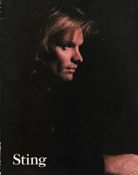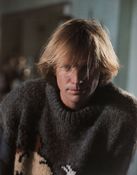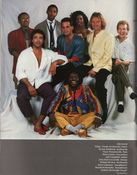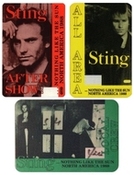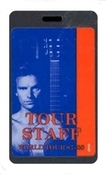
Nothing Like The Sun
Feb
3
1988
New York City, NY, US
Madison Square Garden
1
An exuberant Sting rocks the Garden...
There was Sting, who often seems the soul of severity - chugging an exuberant if somewhat awkward version of the Twist. Was this Madison Square Garden or had we wandered into the Peppermint Lounge?
Hold on - weren't those Sting's bared pectoral muscles on display up there? Surely they were, unless Arnold Schwarzenegger had learned the words to 'Roxanne'.
And wait... a big grin from Sting. Had the Garden's escalators deposited their passengers in the Twilight Zone? Hardly; it was simply that not even Maestro Sting could fail to get caught up by the energy of this two hour and 40 minute show.
Sting has convened a group of musicians for this 11-week U.S. tour that is mouth-watering. And whether you hold his new music in great esteem or pine for the Police's greatest hits, the performances are satisfying.
Sting's show is a chess game, thoughtful and crafted from the opening gambit through the final checks. I'm not suggesting that either the audience or the band are pawns; indeed, Sting rallies his considerable forces against the themes of injustice and tyranny that make up much of the focus of his current record, '...Nothing Like the Sun'. The trick is to entertain as well, and he does.
His opening moves were deliberate, but Sting's joyousness - he was doing the Twist to 'One World' - became infectious toward the end of the first half of this show and throughout the second. At 8:15 sharp, the band was spread upon the wide stage. On 'The Lazarus Heart', Sting's burly tenor bumped against the smooth music supporting his voice.
On a projection screen above the stage, a close-up Sting, with his layered haircut, looked like an '80s version of the Phantom of the Garden.
Kenny Kirkland on keyboards and Branford Marsalis on saxophones took turns freeing some of the new material from Sting's often-melancholy and rather mechanical grip. Kirkland, who broke into the musical stratosphere during 'When the World Is Running Down (You Make the Best of What's Still Around)', is the red-jacketed Buddha of the band, dispensing happy faces all over the places and playing so effortlessly, his fingers so nonchalant, that a couple of times I thought he must have been fronting a nuclear-powered player piano.
Sting's run-though performances at The Ritz in November, when his band boiled on a close, crowded stage, were more exploratory and informal than this tour set, but Wednesday's show had its incendiary moments too. The opening bars, in the first half, of 'If You Love Somebody Set Them Free' drew an enormous cheer, the first connection of the night, nearly an hour into the performance.
The mournful strains of 'They Dance Alone' set up the second part of the show, and Sting's voice, which sometimes sounds fractured, was pure and liquid in front of the poignant, beautiful melody.
'Fragile' is another moving song coloured by Sting's acoustic guitar that worked nearly as well. Seguing into 'Little Wing', Sting shifted moods. With the band sounding like a symphony, guitarist Jeff Campbell roiled through Jimi Hendrix' dreamy love song.
'Fortress Around Your Heart' is one of the beacons of Sting's work, a cinematic spectacle of a song, and I devoured it. There was the obligatory 'Message in a Bottle' and 'Roxanne' with Sting alone on stage. ''Not again,'' he barked when the crowd shouted for 'Roxanne'. ''Gimme a break... one night off, just once.''
Then, of course, he sang it.
One fine New York touch: with Kirkland and bass player Tracy Wormworth together on stage - the two are a couple - Sting sang to them the evocative 'Secret Marriage', the poem that closes the new album. So much for Sting's celebrated stoicism. This was rock at its most romantic.
(c) Newsday by Stephen Williams
Sting kicks up his heels...
Forget all those ''C'' words, cold, controlled, and calculating, that have been used to describe Sting. Underneath the former Police-man's cool exterior beats the heart of a warm, engaging, and fun-loving entertainer, who also happens to have something to say with his music.
Performing Wednesday night before a sold-out audience at Madison Square Garden, Sting was in high spirits from the opening beat of 'The Lazarus Heart', slapped out on the congas by percussionist Mino Cinelu, to the exuberant a cappella rendition of 'Message in a Bottle', which closed the show.
Sting shimmied. He strutted. He did a somersault. He even did the Twist (although Chubby Checker has nothing to fear). The performance was in marked contrast to Sting's first solo outing, in which he remained reserved, almost standoffish. Although it's difficult to pinpoint the reason for the change, it appeared that Sting was more comfortable with his band and more assured with his material.
Never lost among Sting's energetic high jinks was his impeccable attention to the music and its message.
The almost three-hour show, with intermission, focused on songs from Sting's two solo albums, with a sprinkling of Police tunes. For his musical inspiration, Sting has increasingly drawn from different realms.
While 'The Dream of the Blue Turtles', his first solo LP, was heavily influenced by jazz, it also drew from classical music (Prokofiev for a passage in 'Russians'). His current album, '...Nothing Like the Sun', is a melange of jazz, reggae, rock, and samba. His lyrics, meanwhile, have drawn attention to the plight of the British coal miner (We Work the Black Seam) and human-rights issues (They Dance Alone Gueca Solo).
It is Sting's willingness to experiment and push at the narrow musical boundaries of rock that have made the former lead singer of the Police one of pop music's most arresting figures. And that reputation was only enhanced by his live performance.
The concert, during which Sting was accompanied by an eight-member band, was one of the most intelligently planned and gracefully executed shows to be seen in an arena in a long time.
Sting's reedy tenor has become richer and more expressive. That vocal maturity resulted in moving renditions of 'They Dance Alone' and 'Little Wing' and playful ones of 'Rock Steady' and 'Straight to My Heart'.
'They Dance Alone', which opened the second half of the show, takes as its inspiration the dance performed by the wives, daughters, and mothers of ''disappeared'' South American political prisoners. The women's anguish was captured by the haunting instrumental blend of Sting's acoustic guitar, Branford Marsalis' soprano saxophone, and Kenny Kirkland's keyboards. Sting and company also captured the women's courage and hope. As the song's slow tempo accelerated into a bright and bouncy samba beat, video footage flashed overhead, showing some of these women, who had joined Sting on stage during one of his concerts in Brazil.
'Little Wing', the Jimi Hendrix classic revamped with a jazz arrangement, showcased the new-found power of Sting's voice as it soared to the upper reaches of Madison Square Garden. Sting's vocal intensity was matched by guitarist Jeff Campbell's searing solo.
Sting said that many considered the 7/4 time of 'Straight to My Heart' a dance proof meter. But the quirky, punchy beat proved to be anything but. A dancing Sting was joined by thousands who jumped up from their seats to boogie to the song, which was heavily laced with percussion and keyboards and punctuated by handclaps.
The swing arrangement of 'Rock Steady' was enhanced by Sting's expressive vocals. The pacing of the concert was also exquisite, as Sting mixed uptempo songs with midtempo ones. At other times, he established a smooth flow, allowing one song to blend into another. The jaunty beat of 'Englishman in New York', which evoked huge cheers given the setting, faded as Marsalis began a bluesy saxophone solo. That proved to be the perfect bridge to the song that followed, the blues-based 'Sister Moon'.
'Fragile', with its gentle guitar base, gave way to the opening delicacy of 'Little Wing'. While Sting, who performed bare-chested in a white jacket (later exchanged for a royal blue one) and red-accented tuxedo trousers, rarely relinquished centre stage, he allowed latitude to his band members.
Consequently, many of the songs were punctuated by improvisation. (In addition to those previously mentioned, the group included bass player Tracy Wormworth, drummer Jean Paul Ceccarelli, keyboard player Delmar Brown, and vocalist Dolette McDonald.). Kirkland and Marsalis, two holdovers from Sting's first solo touring unit, were exceptional throughout.
Marsalis, favouring the soprano saxophone for much of the performance, filled many moments with lovely, lyrical play. Particularly moving was his stirring solo amid the delicately reworked 'Roxanne'.
Kirkland, meanwhile, added his powerful piano touch to 'One World' and 'Consider Me Gone'. The latter song also benefited from the spirited scatting of keyboard player Brown.
But the night belonged to Sting, who set out to challenge the stagnant musical community and triumphed.
(c) The Bergen Record by Barbara Jaeger
Sting at Garden...
Hans Eisler, a composer who worked with Bertolt Brecht, might well have been amused to hear one of his melodies sung at Madison Square Garden with teen-age girls shrieking at the end of each chromatic phrase.
But that was only one of the unlikely treats at Wednesday's concert by Sting, who somehow balances musicianly experiments and melancholy, high-minded songs with the charisma and showmanship of a pop star.
Since the dissolution of the Police in 1983-84, Sting has moved away from ordinary pop, writing songs about such topics as political prisoners in Chile (They Dance Alone) and terrorist violence (Fragile) as well as love songs; he works with musicians adept at jazz, rock and dance music, putting together bands that can knock out anything from internationalist funk to anthemic rock to a torch song. But along with the momentum of his career as the Police's singer and songwriter, he has maintained enough pop craftsmanship to keep his music on the radio; so far, his ambitions haven't overreached his popularity.
Where Sting's songs themselves have grown increasingly morose, the festive atmosphere of a rock concert acts as a corrective.
Sting struts, dances with band members and acts out some lyrics with broad gestures; he puts himself in character for more sombre songs, too, but doesn't dwell on them.
In concert, Sting gives his musicians some room to improvise, and after working together since November (with one change, a new drummer - Jean-Paul Ceccarelli), his current band can not only dig into a rhythmic groove, but also transform it from the inside out; Kenny Kirkland, on keyboards, couldn't resist turning funk into salsa on Wednesday.
In two hours and 20 minutes of music, Sting performed all the songs from his current album, '...Nothing Like the Sun', from the dance throwaway 'We'll Be Together' to the intricate, odd-meter 'Straight to My Heart' to Jimi Hendrix's rock ballad 'Little Wing' (with added lyrics from the Beatles' 'From Me to You,' making it a double tribute to dead 1960's rockers) to the Eisler adaptation, 'Secret Marriage' - far more musical variety than most arena-pop bands deliver.
Sting has said he wants to break down musical categories, and at Madison Square Garden he did just that, amid the screams.
(c) The New York Times by Jon Pareles
There was Sting, who often seems the soul of severity - chugging an exuberant if somewhat awkward version of the Twist. Was this Madison Square Garden or had we wandered into the Peppermint Lounge?
Hold on - weren't those Sting's bared pectoral muscles on display up there? Surely they were, unless Arnold Schwarzenegger had learned the words to 'Roxanne'.
And wait... a big grin from Sting. Had the Garden's escalators deposited their passengers in the Twilight Zone? Hardly; it was simply that not even Maestro Sting could fail to get caught up by the energy of this two hour and 40 minute show.
Sting has convened a group of musicians for this 11-week U.S. tour that is mouth-watering. And whether you hold his new music in great esteem or pine for the Police's greatest hits, the performances are satisfying.
Sting's show is a chess game, thoughtful and crafted from the opening gambit through the final checks. I'm not suggesting that either the audience or the band are pawns; indeed, Sting rallies his considerable forces against the themes of injustice and tyranny that make up much of the focus of his current record, '...Nothing Like the Sun'. The trick is to entertain as well, and he does.
His opening moves were deliberate, but Sting's joyousness - he was doing the Twist to 'One World' - became infectious toward the end of the first half of this show and throughout the second. At 8:15 sharp, the band was spread upon the wide stage. On 'The Lazarus Heart', Sting's burly tenor bumped against the smooth music supporting his voice.
On a projection screen above the stage, a close-up Sting, with his layered haircut, looked like an '80s version of the Phantom of the Garden.
Kenny Kirkland on keyboards and Branford Marsalis on saxophones took turns freeing some of the new material from Sting's often-melancholy and rather mechanical grip. Kirkland, who broke into the musical stratosphere during 'When the World Is Running Down (You Make the Best of What's Still Around)', is the red-jacketed Buddha of the band, dispensing happy faces all over the places and playing so effortlessly, his fingers so nonchalant, that a couple of times I thought he must have been fronting a nuclear-powered player piano.
Sting's run-though performances at The Ritz in November, when his band boiled on a close, crowded stage, were more exploratory and informal than this tour set, but Wednesday's show had its incendiary moments too. The opening bars, in the first half, of 'If You Love Somebody Set Them Free' drew an enormous cheer, the first connection of the night, nearly an hour into the performance.
The mournful strains of 'They Dance Alone' set up the second part of the show, and Sting's voice, which sometimes sounds fractured, was pure and liquid in front of the poignant, beautiful melody.
'Fragile' is another moving song coloured by Sting's acoustic guitar that worked nearly as well. Seguing into 'Little Wing', Sting shifted moods. With the band sounding like a symphony, guitarist Jeff Campbell roiled through Jimi Hendrix' dreamy love song.
'Fortress Around Your Heart' is one of the beacons of Sting's work, a cinematic spectacle of a song, and I devoured it. There was the obligatory 'Message in a Bottle' and 'Roxanne' with Sting alone on stage. ''Not again,'' he barked when the crowd shouted for 'Roxanne'. ''Gimme a break... one night off, just once.''
Then, of course, he sang it.
One fine New York touch: with Kirkland and bass player Tracy Wormworth together on stage - the two are a couple - Sting sang to them the evocative 'Secret Marriage', the poem that closes the new album. So much for Sting's celebrated stoicism. This was rock at its most romantic.
(c) Newsday by Stephen Williams
Sting kicks up his heels...
Forget all those ''C'' words, cold, controlled, and calculating, that have been used to describe Sting. Underneath the former Police-man's cool exterior beats the heart of a warm, engaging, and fun-loving entertainer, who also happens to have something to say with his music.
Performing Wednesday night before a sold-out audience at Madison Square Garden, Sting was in high spirits from the opening beat of 'The Lazarus Heart', slapped out on the congas by percussionist Mino Cinelu, to the exuberant a cappella rendition of 'Message in a Bottle', which closed the show.
Sting shimmied. He strutted. He did a somersault. He even did the Twist (although Chubby Checker has nothing to fear). The performance was in marked contrast to Sting's first solo outing, in which he remained reserved, almost standoffish. Although it's difficult to pinpoint the reason for the change, it appeared that Sting was more comfortable with his band and more assured with his material.
Never lost among Sting's energetic high jinks was his impeccable attention to the music and its message.
The almost three-hour show, with intermission, focused on songs from Sting's two solo albums, with a sprinkling of Police tunes. For his musical inspiration, Sting has increasingly drawn from different realms.
While 'The Dream of the Blue Turtles', his first solo LP, was heavily influenced by jazz, it also drew from classical music (Prokofiev for a passage in 'Russians'). His current album, '...Nothing Like the Sun', is a melange of jazz, reggae, rock, and samba. His lyrics, meanwhile, have drawn attention to the plight of the British coal miner (We Work the Black Seam) and human-rights issues (They Dance Alone Gueca Solo).
It is Sting's willingness to experiment and push at the narrow musical boundaries of rock that have made the former lead singer of the Police one of pop music's most arresting figures. And that reputation was only enhanced by his live performance.
The concert, during which Sting was accompanied by an eight-member band, was one of the most intelligently planned and gracefully executed shows to be seen in an arena in a long time.
Sting's reedy tenor has become richer and more expressive. That vocal maturity resulted in moving renditions of 'They Dance Alone' and 'Little Wing' and playful ones of 'Rock Steady' and 'Straight to My Heart'.
'They Dance Alone', which opened the second half of the show, takes as its inspiration the dance performed by the wives, daughters, and mothers of ''disappeared'' South American political prisoners. The women's anguish was captured by the haunting instrumental blend of Sting's acoustic guitar, Branford Marsalis' soprano saxophone, and Kenny Kirkland's keyboards. Sting and company also captured the women's courage and hope. As the song's slow tempo accelerated into a bright and bouncy samba beat, video footage flashed overhead, showing some of these women, who had joined Sting on stage during one of his concerts in Brazil.
'Little Wing', the Jimi Hendrix classic revamped with a jazz arrangement, showcased the new-found power of Sting's voice as it soared to the upper reaches of Madison Square Garden. Sting's vocal intensity was matched by guitarist Jeff Campbell's searing solo.
Sting said that many considered the 7/4 time of 'Straight to My Heart' a dance proof meter. But the quirky, punchy beat proved to be anything but. A dancing Sting was joined by thousands who jumped up from their seats to boogie to the song, which was heavily laced with percussion and keyboards and punctuated by handclaps.
The swing arrangement of 'Rock Steady' was enhanced by Sting's expressive vocals. The pacing of the concert was also exquisite, as Sting mixed uptempo songs with midtempo ones. At other times, he established a smooth flow, allowing one song to blend into another. The jaunty beat of 'Englishman in New York', which evoked huge cheers given the setting, faded as Marsalis began a bluesy saxophone solo. That proved to be the perfect bridge to the song that followed, the blues-based 'Sister Moon'.
'Fragile', with its gentle guitar base, gave way to the opening delicacy of 'Little Wing'. While Sting, who performed bare-chested in a white jacket (later exchanged for a royal blue one) and red-accented tuxedo trousers, rarely relinquished centre stage, he allowed latitude to his band members.
Consequently, many of the songs were punctuated by improvisation. (In addition to those previously mentioned, the group included bass player Tracy Wormworth, drummer Jean Paul Ceccarelli, keyboard player Delmar Brown, and vocalist Dolette McDonald.). Kirkland and Marsalis, two holdovers from Sting's first solo touring unit, were exceptional throughout.
Marsalis, favouring the soprano saxophone for much of the performance, filled many moments with lovely, lyrical play. Particularly moving was his stirring solo amid the delicately reworked 'Roxanne'.
Kirkland, meanwhile, added his powerful piano touch to 'One World' and 'Consider Me Gone'. The latter song also benefited from the spirited scatting of keyboard player Brown.
But the night belonged to Sting, who set out to challenge the stagnant musical community and triumphed.
(c) The Bergen Record by Barbara Jaeger
Sting at Garden...
Hans Eisler, a composer who worked with Bertolt Brecht, might well have been amused to hear one of his melodies sung at Madison Square Garden with teen-age girls shrieking at the end of each chromatic phrase.
But that was only one of the unlikely treats at Wednesday's concert by Sting, who somehow balances musicianly experiments and melancholy, high-minded songs with the charisma and showmanship of a pop star.
Since the dissolution of the Police in 1983-84, Sting has moved away from ordinary pop, writing songs about such topics as political prisoners in Chile (They Dance Alone) and terrorist violence (Fragile) as well as love songs; he works with musicians adept at jazz, rock and dance music, putting together bands that can knock out anything from internationalist funk to anthemic rock to a torch song. But along with the momentum of his career as the Police's singer and songwriter, he has maintained enough pop craftsmanship to keep his music on the radio; so far, his ambitions haven't overreached his popularity.
Where Sting's songs themselves have grown increasingly morose, the festive atmosphere of a rock concert acts as a corrective.
Sting struts, dances with band members and acts out some lyrics with broad gestures; he puts himself in character for more sombre songs, too, but doesn't dwell on them.
In concert, Sting gives his musicians some room to improvise, and after working together since November (with one change, a new drummer - Jean-Paul Ceccarelli), his current band can not only dig into a rhythmic groove, but also transform it from the inside out; Kenny Kirkland, on keyboards, couldn't resist turning funk into salsa on Wednesday.
In two hours and 20 minutes of music, Sting performed all the songs from his current album, '...Nothing Like the Sun', from the dance throwaway 'We'll Be Together' to the intricate, odd-meter 'Straight to My Heart' to Jimi Hendrix's rock ballad 'Little Wing' (with added lyrics from the Beatles' 'From Me to You,' making it a double tribute to dead 1960's rockers) to the Eisler adaptation, 'Secret Marriage' - far more musical variety than most arena-pop bands deliver.
Sting has said he wants to break down musical categories, and at Madison Square Garden he did just that, amid the screams.
(c) The New York Times by Jon Pareles


